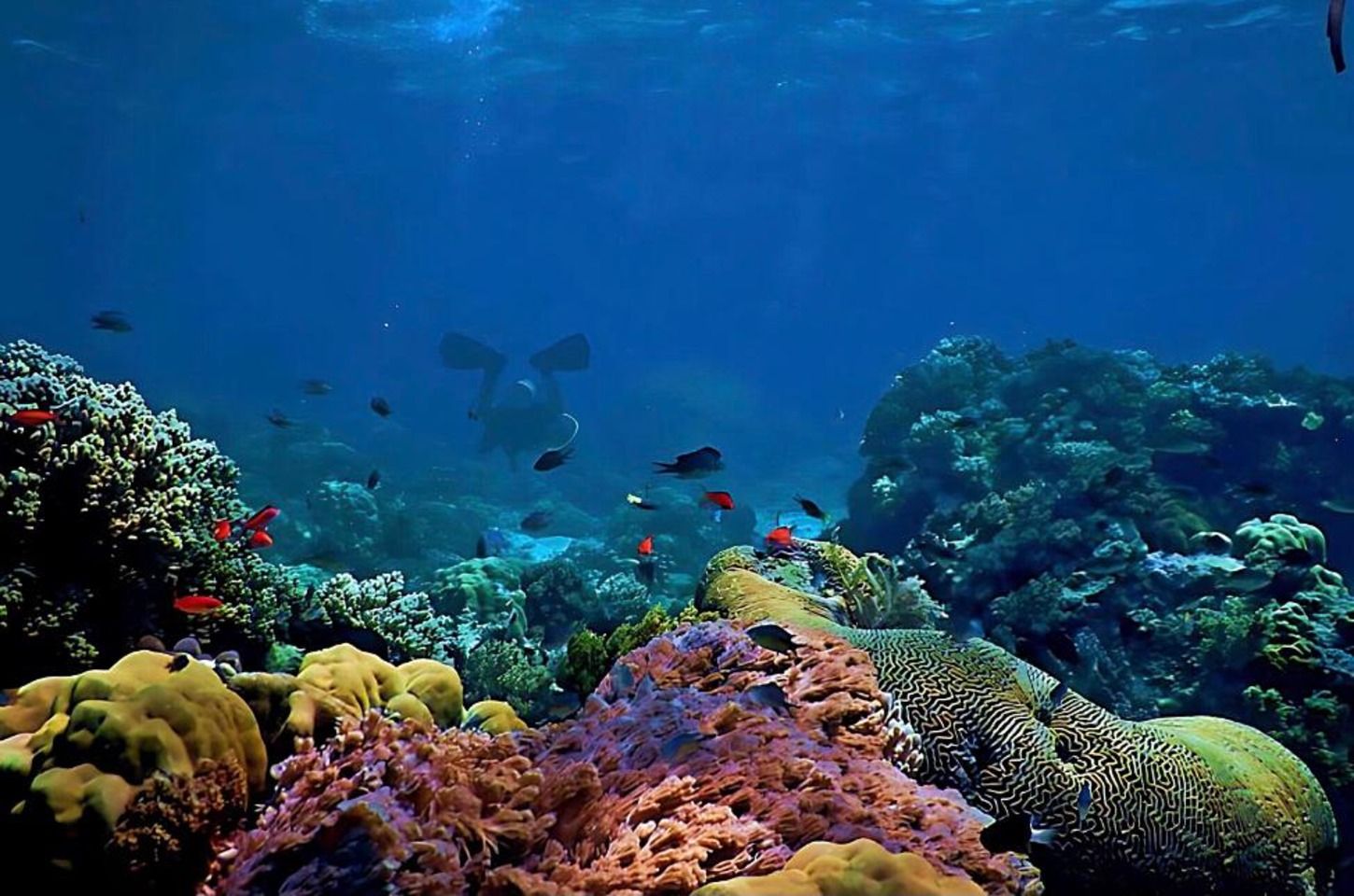
Countries That Have Banned Chemical SPF’s and Why
There is controversy about chemical SPF filters and their impact on the environment, including coral reefs. Learn why chemical SPF is banned in certain places, and how to choose the best non-nano SPF.
By Valerie George | 8 Min. Read
February 5, 2023Sun safety is the most important thing to protect the skin from cancer, burn and premature aging, but where does all that sunscreen go after its applied to your body? While some of it rubs off on your clothing or goes down your shower drain, about 25% of it gets released into water during swimming or bathing, according to one study.1 Only been recently have scientists studied various UV filters in sunscreen and their impact on coral reef systems, and their findings have not been favorable to certain classes of sunscreen ingredients. In fact, this research has led to several countries worldwide banning certain sunscreen ingredients.
Which SPF ingredients have been banned?
There are two primary sunscreen categories on the market: those with physical UV filters and those with chemical UV filters. Physical UV filters are physical particles that sit on the skin and work by blocking, absorbing, and scattering the sun’s rays. These physical particles are typically zinc oxide or titanium dioxide. Sunscreens with chemical filters absorb ultraviolet light from the sun, a reaction that generates small amounts of heat on skin, sometimes destroying the chemical compound. While both ingredients are produced through a chemical reaction, chemical filters are produced from reactions of benzene chemistry, which is derived from petroleum.
While there are only two primary physical UV filters, there are dozens of chemical filters on the market, all with varying degrees of biodegradability. There are two chemical filters that have undergone vast scrutiny due to their accumulation in the environment and inability to readily break down—oxybenzone and octinoxate. While these chemical filters have been safe for use for humans over the decades, they’re thought to be harmful to aquatic life due to the ability of plants and organisms to absorb these compounds.
Why are chemical sunscreens bad for the environment?
Coral reefs are made by living organisms called coral polyps. They play an important role in under water life, as about 25% of the ocean’s fish depend on healthy coral reefs. Coral reefs found in shallow water also play an important role in protecting the coastal areas. They reduce the power of the ocean’s waves crashing against the shoreline, reducing erosion.
When coral undergo stress, they turn white, a term called coral bleaching. Some studies have concluded that certain SPF ingredients contribute to coral bleaching.1 Furthermore, other studies have shown some chemical filters in sunscreens do persist in the environment, which some scientists say damage these ecosystems.
It’s not just coral reefs that are impacted
Shallow water corals also have a symbiotic relationship with algae.2 The algae couldn’t survive without the coral, and the coral couldn’t survive without the algae. Algae are important to our environment because they perform photosynthesis, a process that pulls carbon dioxide from the air and converts it to oxygen.
Other organisms, such as dolphins, sea urchins and mussels can also absorb sunscreen ingredients, such as oxybenzone, octinoxate, benzophenone and nano-zinc oxide. They can accumulate in tissues and impact their fertility and offspring.
Which countries have banned chemical SPF and why?
Some governments have taken matters into their own hands and enacted laws that forbid the sale of certain sunscreen ingredients in their territory. Most of these geographies have vast amounts of coastal area with shallow coral and slow-moving water, a disaster for bioaccumulation.
As of the writing of this article, there are several governments that have placed various restrictions on the sale or import of SPF sunscreens, and more and more will be joining the ranks of these bellwethers:
Palau. The nation of Palau in the Pacific Ocean announced a sunscreen restriction in 2018, which went into effect in 2020. They banned the use of octinoxate and oxybenzone sunscreen ingredients.
Hawaii. The state of Hawaii in the United States was the first government to ban the sale of certain chemical sunscreens on January 1, 2021. Sunscreens with octinoxate and oxybenzone are not permitted for sale, but visitors can bring the sunscreens with them. Currently, a bill is in progress to further restrict two more chemicals, avobenzone and octocrylene.4
Key West. The county of Key West, part of the state of Florida in the United States mirrored the Hawaii sunscreen ban, restricting the sale of octinoxate and oxybenzone in January 2021.
U.S. Virgin Islands. In March 2020, legislators banned the sale of sunscreens containing oxybenzone and octinoxate.
Bonaire. Following Hawaii, the Caribbean Island of Bonaire announced their restrictions on the sale of sunscreens containing octinoxate and oxybenzone.
Thailand. In 2021, Thailand announced a ban on sunscreens in all of its national parks. The restricted sunscreens are those that contain oxybenzone, octinoxate, 4-methylbenzylidene camphor or butylparaben.
Mexico. While not a country-wide ban, many popular tourist areas have banned non-biodegradable sunscreens, especially in areas where visitors enter the water and may come into contact with marine animals.5
Aruba. In July 2020, Aruba has restricted oxybenzone-containing sunscreens on its island.
What is a biodegradable sunscreen?
While some chemical filters biodegrade in the environment, there are many that don’t ever biodegrade, or don’t readily biodegrade. To avoid any confusion in which is what, it is best and easiest to use sunscreens that are biodegradable. These include sunscreens like SunsolveMD Detox and Shield Mineral SPF50, which contains a non-nano zinc oxide. It has long been substantiated that zinc oxide is a biodegradable compound and does not accumulate in the environment.
Of course, there are other ingredients in sunscreens, not just the UV filter itself, so check to see if the overall product has been tested for biodegradability. The brand might have a reef-safe certification,6 which also checks that the product is formulated without these other ingredients that are thought to harm aquatic life:
- Oxybenzone (Benzophenone-3)
- Octinoxate (Octyl Methoxycinnamate)
- Octocrylene
- 4-Methylbenzylidene Camphor
- PABA derivatives (e.g. Ethylhexyl Dimethyl PABA and PEG-25 PABA)
- Octisalate (Ethylhexyl Salicylate)
- Homosalate
- Avobenzone (Butyl Methoxydibenzoylmethane)
- Parabens
- Phthalates
- Triclosan
- Microplastics
- Nanomaterials
This pretty much leaves us with zinc oxide or titanium dioxide-based sunscreen, and the evidence is pretty clear that this is the best choice for a sustainable sunscreen. There are some additional considerations to keep in mind when selecting the best one.
Make sure your zinc oxide is non-nano
Once you’ve found the ideal zinc oxide sunscreen, it’s important to make sure it’s non-nano. While nanomaterials are considered safe for use on humans, more research is being conducted on their safety. And, while they may be safe for humans, they have been found to accumulate in aquatic life, like dolphins.3 Therefore, they should be avoided. All of SunsolveMD’s sunscreens contain non-nano zinc oxide to ensure human and environmental safety.
Choose a traditional sunscreen lotion format
Many people wonder if their chemical SPF causes cancer but rest assured that SPF ingredients are highly studied by toxicologists and scientists for safety. If they caused cancer, they would not be allowed for use in sunscreens in the US and EU. In fact, the US has some of the most rigorous requirements for approving SPF filters on the market, since they are considered drug actives. However, this approval only takes into consideration human safety. While SPF filters are safe for humans, they may not necessarily be great for the environment. In fact, researchers agree that more work needs to be done to understand the implications chemical UV filters have in our ecosystem.7,8
However, there is recent concern about a carcinogen being found in sunscreens called benzene. Benzene is not found in the chemical SPF filters themselves, but rather in other ingredients that may be present. This is not a widespread issue, but rather related to the format the sunscreen is applied—aerosols. The propellant in aerosol sunscreens that pressurizes the aluminum canister may contain trace amounts of benzene, which is a carcinogen. For this reason alone, it is best to avoid aerosols. However, there are many other reasons to stick with a traditional sunscreen format.
Not only might you not be getting the SPF value you think you’re getting with an aerosol due to improper application, but you may also be missing out on the other skin-beneficial benefits a lotion can deliver to skin.
In addition to ultraviolet light, the sun emits high energy visible light. This light, which includes blue light, can be damaging to skin.9 Growing evidence supports that this high energy light can penetrate into the deeper layers of skin, causing hyperpigmentation and premature aging. Choosing a sunscreen with technologies that care for skin during UV light and HEV light exposure, and after, will cover your bases. Not only does zinc oxide provide protection in the HEV light spectrum, a technology like SunsolveMD EnviroSolve™ protects skin in the HEV light range. SunsolveMD Bio-Phenol-5 Complex™ additionally supports skin with polyphenol antioxidants to reduce the stress that skin endures during sun exposure.
Zinc oxide sunscreen isn’t what it used to be
You may be hesitant to try a zinc oxide-based sunscreen, even though you know it is a smart, environmentally friendly choice. Today’s zinc oxide sunscreens aren’t necessarily the formulations from your childhood, where big, chalky white swaths were left streaked across skin. In fact, zinc oxide technology has come a long way over the years and is no longer just the sunscreen choice of lifeguards. Ingredient manufacturers have worked diligently to create zinc oxide that has an optimum, non-nano particle size that is aesthetically pleasing. SunsolveMD employs this technology so that the sunscreen leaves a thin, protective layer on skin that is clear—not chalky. This makes it not only ideal for daily use, but makes it a sunscreen that people want to wear daily.
References
Danovaro R, Bongiorni L, Corinaldesi C, et al. Sunscreens cause coral bleaching by promoting viral infections. Environ Health Perspect. 2008;116(4):441-447. doi:10.1289/ehp.10966
Coral Reef Ecosystems. National Oceanic and Atmospheric Administration. (n.d.). Retrieved February 1, 2023, from https://www.noaa.gov/education/resource-collections/marine-life/coral-reef-ecosystems
US Department of Commerce, N. O. and A. A. (2018, November 1). Sunscreen chemicals and coral reefs. Skincare Chemicals and Marine Life. Retrieved February 1, 2023, from https://oceanservice.noaa.gov/news/sunscreen-corals.html
Government of the State of Hawaii. (n.d.). H.B. no 102, A bill for an act relating to sunscreens. HB102. Retrieved February 1, 2023, from https://www.capitol.hawaii.gov/sessions/session2021/bills/HB102_.HTM
Durso, S., Durso, W. by S., Durso, S., & Caggiano, C. (n.d.). What to know about the sunscreen ban in certain destinations. Going Places | One World. Many Destinations. Retrieved February 1, 2023, from https://www.onetravel.com/going-places/what-to-know-about-sunscreen-ban/
Cosmetic certification: Reef friendly. Biorius. (2022, December 10). Retrieved February 1, 2023, from https://biorius.com/cosmetics-certifications/reef-friendly-certification/
Levine A. Reducing the prevalence of chemical UV filters from sunscreen in aquatic environments: Regulatory, public awareness, and other considerations. Integr Environ Assess Manag. 2021;17(5):982-988. doi:10.1002/ieam.4432
